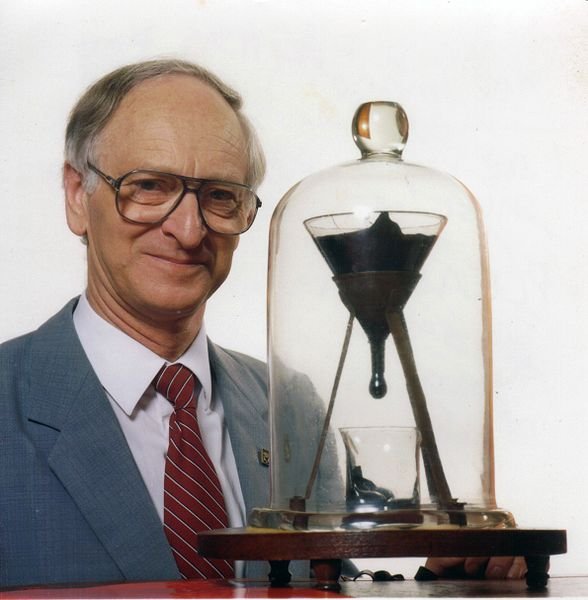
The root of science has always been answering questions derived from our observation and curiosity and to answer those questions and satisfy our curiosity, we turn to experiment to validate or disconfirm our proposed hypothesis.
While most experiment averages around 2 to 3 years to get answers, some experiments can take much longer, so long that even the researchers initially working on the experiment are long gone and that the initial research question has either been changed or forgotten entirely.
One of those experiment is the Pitch drop experiment

It involves watching something drop at a rate slower than the full rotation of the planet Venus and in case you’re wondering how long does it take for Venus to complete one full rotation on its axis, the answer is a whopping 243 Earth days.
Venus has a reputation for being the slowest rotating planet in our solar system so much so that if you were to compare between the axial rotation and orbital rotation of Venus, the rotation around its axis takes 19 days longer compared to its revolution around the sun!
Anyway, I digressed, the pitch drop experiment is an attempt to show that looks can be deceiving and that there’s more than meets the eye when it comes to pitch. This tar derivative fools every naïve eyes into thinking that it is a solid when in fact, it’s actually a very very high viscosity fluid, giving it the texture and the look of a solid. That said, the pioneer of this experiment, Professor Thomas Parnell from the University of Queensland, Australia, wanted to prove his point by showing that pitch can flow drop by drop like a fluid would but the only drawback is that it takes a ridiculously long period of time for one drop to fall.
To do this, an amount of pitch was put into a funnel which drains down into a beaker and if the beaker is filled with pitch, it will cement his proposed hypothesis. The next thing to do was just wait, like a long wait.
How long? Well the first drop took a mind-boggling 98 months (8.1 years) to fall and ever since its commencement back in 1927, this 90-plus year old experiment has recorded 9 drops with the latest one on April 2014. Now, all eyes are set to watch the next big moment, waiting to see the tenth one to fall.
BUT WHY
Yeah why dude?
I mean Parnell kind of proved his point already with the first drop and he could have stopped with the second one, is he trying to rub his “I TOLD YOU SO” onto the future generation or something?
Well, the answer has little to do with Parnell and more on the observation of the experiment. You see, after 8 drops, they realised that no one had actually witnessed the drop falling, they simply found the beaker to be increased in volume the next day, signifying a drop has been added.
The first chance to actually record the event on camera came in the year 2000 but a poorly-timed power cut meant that it wasn’t to be and so the pursuit to actually witnessing the drop persisted all the way until the year 2014 and yes, it was recorded on camera.
Furthermore, taking more than one number of drop and the respective intervals is important because it allow researchers to calculate the estimated viscosity of Pitch which is around 230 billion (2.3×1011) times to that of water
Plus, the serial intervals depicted something rather peculiar about the behaviour of the pitch – It got longer.
Ever since the 3rd drop in April 1954, the time it took for the next drop to occur got longer and longer and it wasn’t like they were trying to keep it in a control environment, they just put it in a display cabinet. Some might argue that it’s because of the installment of air conditioning following the 7th drop which led to the long drop interval but it doesn’t explain why it keeps on getting longer and longer, if anything there should be a plateau.
CURRENT UPDATE
The next drop or the tenth drop is expected to be somewhere in the year 2020s and more than 30 thousand people from over 150 countries had signed up to view the live stream of this experiment. Case in point, according to the Guinness Book of World Records, this is the world’s longest running laboratory experiment in human history.
Thank you for reading, hope you enjoyed this post.
Be sure to Vote, Comment, Resteem and Follow me for more awesome content. For further reading, be sure to check out the references below:
A really long one............Interesting though
Peace, Abundance, and Liberty Network (PALnet) Discord Channel. It's a completely public and open space to all members of the Steemit community who voluntarily choose to be there.Congratulations! This post has been upvoted from the communal account, @minnowsupport, by thethinkingdr from the Minnow Support Project. It's a witness project run by aggroed, ausbitbank, teamsteem, theprophet0, someguy123, neoxian, followbtcnews, and netuoso. The goal is to help Steemit grow by supporting Minnows. Please find us at the
If you would like to delegate to the Minnow Support Project you can do so by clicking on the following links: 50SP, 100SP, 250SP, 500SP, 1000SP, 5000SP.
Be sure to leave at least 50SP undelegated on your account.
This post has been curated by TeamMalaysia Community :-
To support the growth of TeamMalaysia Follow our upvotes by using steemauto.com and follow trail of @myach
Vote TeamMalaysia witness bitrocker2020 using this link vote for witness